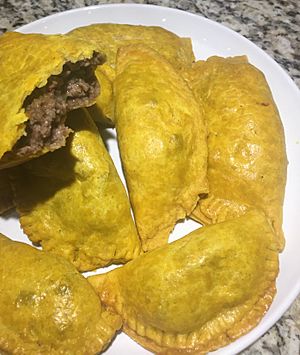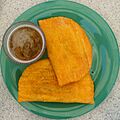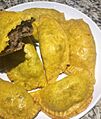Jamaican patty facts for kids
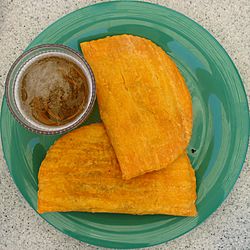
A plate of Jamaican patties
|
|
| Type | Pastry |
|---|---|
| Course | Snack |
| Place of origin | Jamaica |
| Region or state | Americas |
| Serving temperature | Hot |
A Jamaican patty is a yummy, half-moon-shaped pastry. It has different fillings and spices baked inside a flaky, golden crust. The crust often gets its yellow color from egg yolk or a spice called turmeric. It's made like a turnover, where dough is folded over a filling. But patties are usually savory and filled with ground meat.
As the name tells you, it's very popular in Jamaica. You can also find it in other Caribbean places like Nicaragua, Panama, and Costa Rica. Traditionally, it's filled with seasoned ground beef. But fillings can also include chicken, pork, lamb, vegetables, shrimp, lobster, fish, soy, ackee, mixed vegetables, or cheese.
In Jamaica, people often eat a patty as a full meal, especially with coco bread. You can also find smaller versions called cocktail patties. In the United Kingdom, Jamaican patties might have a crust made with margarine or butter. This makes them flaky and often includes curry powder for the yellow color.
Contents
The Story of Jamaican Patties
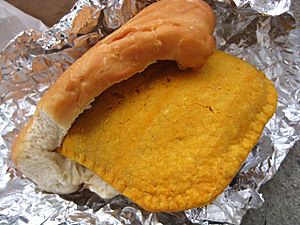
The beef patty has a long and interesting history in Jamaica. It's a mix of different cultures! Pasties were brought by people from Cornwall (a part of England). Spices like cumin, curry, and cayenne pepper came from people who arrived from India and Africa. These different influences all came together to create the Jamaican patty we know today. The spicy Scotch bonnet pepper, which grows in Jamaica, added a special kick to the flavor.
In the 1960s and 1970s, many Jamaicans moved to places like the United States and the United Kingdom. They brought their delicious patty recipes with them! Soon, patties became popular in cities with many Caribbean people, like New York City, Birmingham, Manchester, and London. Their popularity is still growing, and you can now find them in many regular stores.
Patties are also very popular in Toronto, Montreal, Miami, and Washington, D.C.. In these places, you can often buy them in grocery stores, delis, and convenience stores. Today, Jamaican patties are often made in large batches and frozen. This makes it easy to sell them in many supermarkets and even in pizza restaurants.
The "Patty Wars" in Canada
In 1985, something funny happened in Toronto, Canada, called the "patty wars." The Canadian government noticed that stores were selling "beef patties." But they said these patties didn't fit their official definition of a "patty" for hamburgers. The government wanted the stores to change the name of the Jamaican patties.
This made many people, especially the patty sellers, very upset! They refused to change the name. The news spread quickly in Canada and even in Jamaica. On February 19, 1985, officials and patty sellers met to talk about it. They reached a deal: the patties could be called "Jamaican patty." Everyone celebrated this victory on February 23, 1985.
A newspaper in Toronto even unofficially declared February 23 as "Jamaican Patty Day" in Toronto! This whole story was even made into a CBC documentary in 2022 called Patty vs. Patty.
Patties Today: A Global Snack
Over the past few decades, the Jamaican patty has become super popular around the world. It's no longer just a homemade treat. Now, patties are often made in big factories using machines. They are sold under different brand names in supermarkets and fast-food chains, especially in North America.
In the United States, some restaurants, like pizzerias, offer patties. They are even served in public school lunches! For example, the New York school system gave out more than three million patties in just one year. This shows how much people love Jamaican patties!
Images for kids
-
Coco bread stuffed with a beef patty
See also
 In Spanish: Pati para niños
In Spanish: Pati para niños


